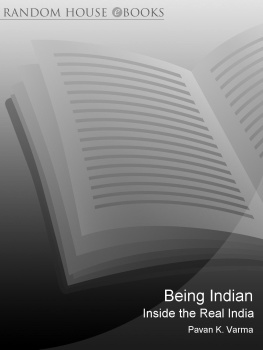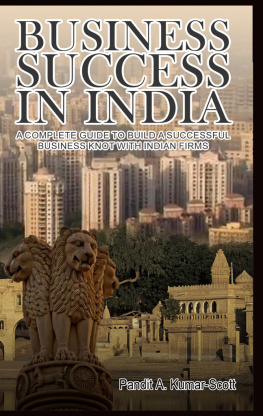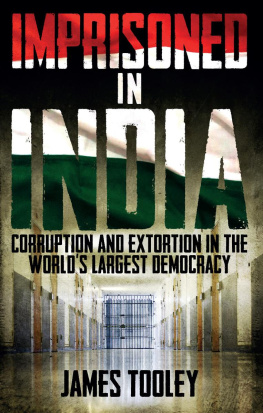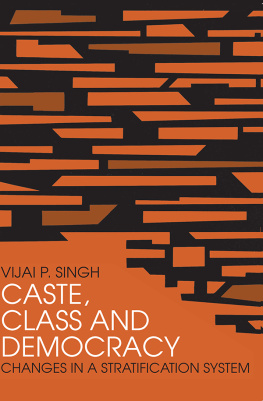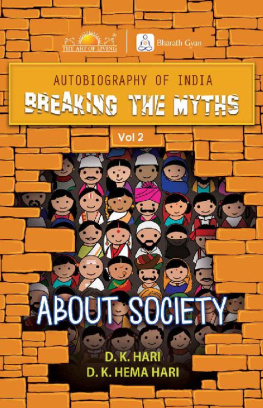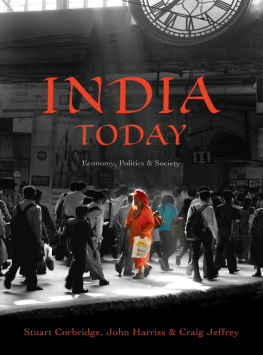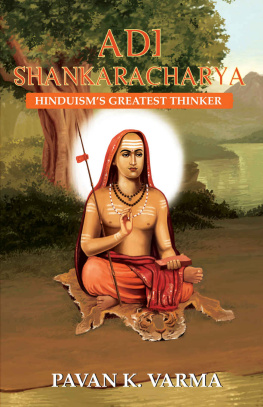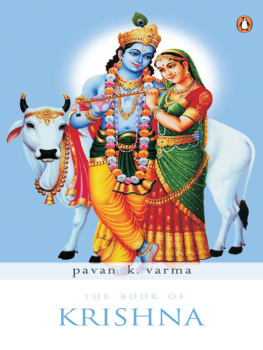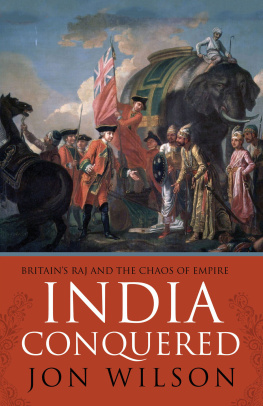About the Book
In the 21st century every sixth human being will be Indian. India is very close to becoming the second largest consumer market in the world, with a buying middle class numbering over half a billion. It is in the top ten in overall GNP. Yet at least 200 million Indians remain desperately poor. Illiteracy rates are high. Communal violence is widespread; corruption endemic. Brides are still tortured and burnt for dowries; the caste system has lost little of its power and none of its brutality.
How are we to make sense of these two, apparently contradictory, pictures of India today? And how can we overcome the many misconceptions about India that are fed by the stereotypes created by foreigners and the myths about themselves projected by Indians? In Being Indian, Pavan Varma, whom the Guardian has called one of the countrys most perceptive writers, demolishes the myths and generalisations as he turns his sharply observant gaze on his fellow countrymen to examine what really makes Indians tick and what they have to offer the world in the 21st century.
A well-researched and urgent inquiry that is informed as much by allusions to Hindu mythological texts as it is by a knowledge of current affairs and popular culture. New Statesman
BEING INDIAN
INSIDE THE REAL INDIA
PAVAN K. VARMA
This eBook is copyright material and must not be copied, reproduced, transferred, distributed, leased, licensed or publicly performed or used in any way except as specifically permitted in writing by the publishers, as allowed under the terms and conditions under which it was purchased or as strictly permitted by applicable copyright law. Any unauthorised distribution or use of this text may be a direct infringement of the authors and publishers rights and those responsible may be liable in law accordingly.
Version 1.0
Epub ISBN 9781448106950
www.randomhouse.co.uk
Published by Arrow Books, 2006
7 9 10 8
Copyright Pavan K. Varma, 2004
The Copyright Acknowledgements page is an extension of this copyright page
Pavan K. Varma has asserted his right under the Copyright, Designs and Patents Act, 1988 to be identified as the author of this work
This book is sold subject to the condition that it shall not, by way of trade or otherwise, be lent, resold, hired out, or otherwise circulated without the publishers prior consent in any form of binding or cover other than that in which it is published and without a similar condition including this condition being imposed on the subsequent purchaser
First published in the Great Britain in 2005 by William Heinemann
Arrow Books
Random House, 20 Vauxhall Bridge Road,
London SW1V 2SA
www.rbooks.co.uk
Addresses for companies within The Random House Group Limited can be found at: www.randomhouse.co.uk/offices.htm
The Random House Group Limited Reg. No. 954009
A CIP catalogue record for this book is available from the British Library
ISBN 9780099486824
Contents
For my mother, Shakuntala,
who passed away a little before
this book was published,
with love and reverence
About the Author
A member of the Indian Foreign Service, Pavan K. Varma has served in Moscow, in New York at the Indian Mission to the UN, and as High Commissioner in Cyprus. He has been Press Secretary to the President of India, official spokesman for the Foreign Office, and is currently director of the Nehru Centre in London. His other books include translations of Hindi poetry, a study of Krishna, and the widely acclaimed The Great Indian Middle Class.
Also by Pavan K. Varma
The Book of Krishna
Ghalib: The Man, The Times
Yudishtar and Draupaid: A Tale of Love, Passions and the Riddles of Existence
Krishna: The Playful Divine
The Great Indian Middle Class
With Renuka Khandekar
Maximize your Life
Mushquilen mujh par padin itni
Ke aasaan ho gayeen
So many hardships came my way
That they were all resolved
Mirza Ghalib
Preface
HARIDWAR, WHERE THE Ganga descends from the Himalayas and enters the plains on its long journey to the sea, is a holy city for Hindus. Thousands of pilgrims visit it everyday. Amidst the hustle and bustle of piety and prayer, a few men can be seen standing even in winter on bare feet in the shallows of the icy river. They have a transparent glass pane in their hands, and spend the day looking through it at the fast-flowing waters. Their unblinking eyes speak of a concentration perhaps greater than that of the throngs of devotees nearby. But their purpose is different: not prayer, not moksha, not salvation for a departed soul. Their attention is focused on the coins on the river bed, which they trace and scoop out expertly with their feet.
India is a difficult country to characterize, and Indians not easy to define, especially today when they are in transition, emerging from the shadows of history into the glare of a globalizing world. This book is an attempt to try and understand who we really are, in the context of the past, and the framework of the future. The task is fraught with dangers. India is too big and too diverse to allow for convenient cover-all labels. To every generalization there is a notable exception. For every similarity there is a significant difference. I would like, therefore, to apologize in advance for anything in this book which hurts the sentiments of some, or appears to be contrary to their perception about themselves. My only consideration has been to paint as truthful a portrait as possible, but I accept that truth is not universal and could have notable exceptions. I must mention too that I have on occasion used the word Hindu and India interchangeably. This is not motivated by any chauvinism, but only because such a large majority of Indians are Hindus. In any case, there are traits which are decidedly Indian, and are applicable to all Indians, irrespective of their religious beliefs.
India appears to be on the threshold of take-off today, but the reasons for this have to go beyond the euphoria of the current feel good wave. In analysing a people who have been in the crucible of history for millennia, no picture can be starkly black or white. Not everything can be right and not everything wrong. The challenge is to draw a balance sheet calculated on the foundational strengths of a people, and to essay the argument that in spite of the obvious weaknesses, the strengths will prevail. Culture, history, and the structure of society play a vital role in this calculation. So does the innate resilience of a people, and their aspirations and ambitions. In our case we must also take into account our inexplicable talent to muddle through, the ability to convert weakness to strength, and, of course, luck.
This book has been researched for several years, but I wrote it mostly when in Cyprus on diplomatic assignment. The beautiful island provided both the setting and the distance to write on a subject so close to my heart. I must express my deep gratitude to David Davidar, now with Penguin Canada, for having first suggested the idea of this book. I am greatly indebted to my agents Malcolm Imrie and Martina Dervis who kept faith in this book, and to Ravi Mirchandani, my editor, the best any author could hope to have. A word of thanks is due too to Cassie Chadderton at Random House. I am also very grateful to William Dalrymple for his friendship and support, and to Bhiku Parekh, Usha Parasher, Rohit Khattar and Salman Mahdi, for theirs. My family is practised now in bearing up stoically with my writing preoccupations. My late mother, with her deep knowledge of Indian culture, was a very willing point of reference. My son Vedanta, and my daughters Manvi and Batasha, often doubled as research assistants, as did their friends, of whom I cannot but mention Rishabh Patel. I am, as always, especially grateful to my wife Renuka for her patience and emotional support, and her views on so many aspects of this book.

